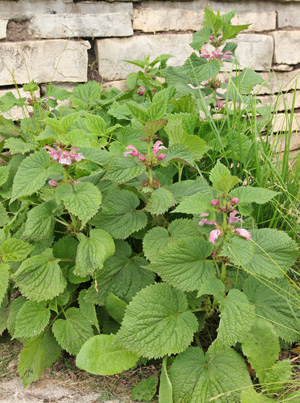
The Lamium most people are familiar with and grow in their gardens is the trailing ground covering spotted deadnettle (L. maculatum and similar types). The species L. orvala, a perennial native to woodlands of Central and Southern Europe, is very different. This upright plant in the mint family grows in neat clumps 18-30 inches tall with coarsely textured, medium green foliage. Unlike its low-growing relatives, giant dead nettle does not spread readily and has a dense, nearly spherical habit that gives it the appearance of a small shrub. It is hardy in zones 4-8.
The plant produces numerous strong, generally unbranched stems each year from the deep-rooted crowns.

The large (up to 6 inches long), alternate, ovate (pointed heart-shape) leaves are finely serrated or toothed along the margins, and covered with tiny white hairs. Prominent veins produce an almost quilted appearance. The leaves are typically a solid green color, although some wild plants do have leaves with a silver stripe down the midrib. The leaves retain a clean appearance through the growing season as long as there is sufficient soil moisture. It is considered drought tolerant but will turn yellow and spotted late in the summer if too dry.
In spring and early summer, whorls of hooded, almost orchid-like flowers are produced in whorls around the upper leaf axils, bursting from purple-pink buds surrounded by green pointed bracts (the calyx). Each velvety pink to purple flower has the two lips typical of the mint family (bilabiate). The hood-like upper lip is fringed with white hairs, while the flared, frilled lower lip sports an interesting spotted pattern. There may be sporadic flowers here and there into the fall but most of the bloom occurs early in the year. The flowers are attractive to bees.

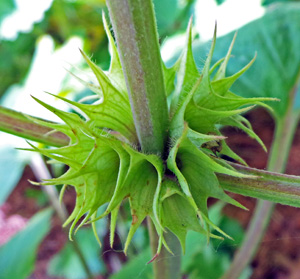
The spiky green bracts remain after the petals fall, containing the small seeds that readily fall out as they ripen and change from green to dull brown. Some plants tend to become leggy after flowering and may flop open later in the summer.
Although the flowers are very attractive, they are so ephemeral and the plant itself is bold enough that it could be utilized primarily as a foliage plant.
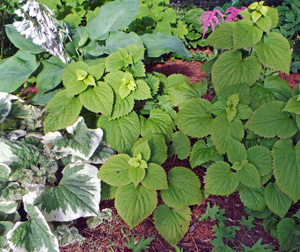
Use L. orvala in shady beds and borders to provide contrast to plants with fine textured foliage or grassy leaves. Combine it with spring bulbs, ferns and a variety of shade-loving perennials, such as blue or variegated hostas, astilbe, globeflower (Trollius europaeus) and Japanese forest grass (Hakonechloa macra) in the woodland garden. Pink-flowered plants that bloom at the same time, such as selected cultivars of lungwort (Pulmonaria) or several species of Geranium, will create a nice color echo to highlight the Lamium flowers.
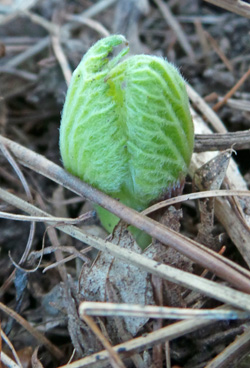
For best growth, plant L. orvala in partial to nearly full shade in a moist but well-drained soil. It is a bit slow growing, so may take a few seasons to establish and form a large clump. Plants can be cut back after flowering, if desired, to encourage fresh, more compact foliar growth.

This plant has few insect or disease problems and is not favored by deer, but will be eaten by rabbits. L. orvala is most often propagated by division of the clumps in early spring or fall but can be grown from seed or cuttings. It may self-seed under ideal conditions. Sow seeds outdoors in the fall or use moist stratification (4-6 weeks of chilling near freezing after 2-4 weeks at room temperature) if grown indoors. Basal cuttings should be taken early before the stems become hollow or stem-tip cuttings of non-flowering stems can be taken in early summer.
A few cultivars are available, including:
- ‘Alba’ (or ‘Album’) – has white flowers and pale green leaves.
- ‘Silva’ – has dusty pink flowers and good erect form. This Piet Oudolf introduction from the Balkans has a subtle and short-lived silver stripe down the midrib of the young leaves.
– Susan Mahr, University of Wisconsin – Madison





 Alternatives to Lawn: Groundcovers
Alternatives to Lawn: Groundcovers Marigolds
Marigolds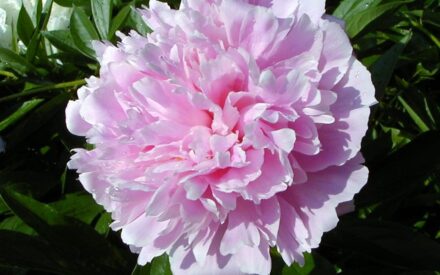 Peony
Peony Iris Severe Mosaic
Iris Severe Mosaic


